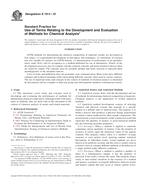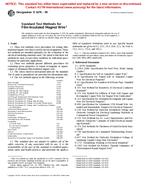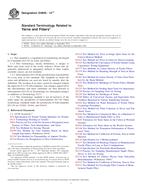1.1 This practice covers what information should be obtained to uniquely identify any soil sampling or examination site where an absolute and recoverable location is necessary for quality control of the study, such as a waste disposal project. The minimum set of data elements for sampling site identification (DEFFSI) was developed considering the needs for informational data bases, such as geographic information systems (GIS). Other distinguishing details, such as individual site characteristics help in singularly cataloging the site. For studies that are not environmentally regulated, such as for an agricultural or preconstruction survey, the data specifications established an agency or company may be different from that of the minimum set (see Guide D420 and Practice D5254).
1.2 As used in this practice, a soil sampling site is meant to be a single point, not a geographic area or property, located by an X, Y, and Z coordinate position at land surface or a fixed datum. All soil data collected for the site are directly related to the coordinate position, for example, sample from x feet (or metres) or sample from interval x1 to x² ft (or metres) below the X, Y, and Z coordinate position. A soil sampling site can include a test well, augered or bored hole, excavation, grab sample, test pit, sidewall sample, stream bed, or any other site where samples of the soil can be collected or examined for the purpose intended.
1.3 The collection of soil samples is a disruptive procedure as the material is usually extracted from its natural environment and then transported from the site to a laboratory for analysis. Normally, in this highly variable type of material, the adjacent soil profile will not be precisely the same as the sampled soil. For these reasons, when soil samples are removed the same material cannot be collected from the site later. Therefore, it is essential that the minimum set of DEFSSI be thoroughly documented and identified especially with an accurate location.
1.4 Samples of soil (sediment) filtered from the water of streams, rivers, or lakes are not in the scope of this practice.
Note 1 – There are many additional data elements that may be necessary to identify and to describe a soil sampling site, but are not included in the minimum set of data elements. An agency or company may require additional data elements as a part of their minimum set for a specific project or program.
1.5 This practice includes those data elements that will distinguish a site’s geographical location on Earth, its location by political regimes, its source identifiers, and its individual site characteristics. These elements apply to all soil and geotechnical sampling sites involved in environmental assessment studies. Each category of site, such as a bore hole or excavation, may require additional data elements to be complete.
1.6 Some suggested components and representative codes for coded DEFSSI, for example, “setting”, are those established by Ref (1), by Practice D2487, by the Water Resources Division of the U.S. Geological Survey in Ref (3), and by Boulding in Ref (4) and (5).
Note 2 – The data elements presented in this practice do not uniquely imply a computer data base, but the minimum set of soil data elements that should be collected for entry into any type of permanent file.
1.7 This practice offers a set of instructions for performing one or more specific operations. This document cannot replace education or experience and should be used in conjunction with professional judgment. Not all aspects of this practice may be applicable in all circumstances. This ASTM standard is not intended to represent or replace the standard of care by which the adequacy of a given professional service must be judged, nor should this document be applied without consideration of a project’s many unique aspects. The word “Standard” in the title of this document means only that the document has been approved through the ASTM consensus process.
Product Details
- Published:
- 01/01/2002
- Number of Pages:
- 7
- File Size:
- 1 file , 100 KB


